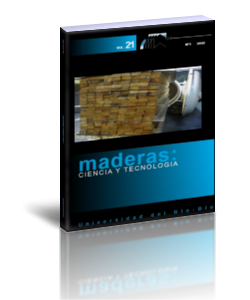Study on compressive stress relaxation behavior of beech based on the finite element method
Keywords:
Fagus orientalis, Maxwell model, mechanical properties, modulus of elasticity, wood structuresAbstract
The compressive stress relaxation behaviors in three directions of beech (Fagus orientalis) were studied by experiments, and predicted by mechanical model and finite element method. Firstly, short-term (3 hours) compressive stress relaxation experiments were carried out in longitudinal (L), radical (R) and tangential (T) directions of beech, and then the experimental data was fitted by mechanical model with two single Maxwell bodies in parallel connection. Secondly, the method of predicting the long-term (12 hours) stress relaxation behaviors of beech based on the finite element method was studied using the experimental data of short-term stress relaxation. Finally, the long-term stress relaxation behaviors in three directions of beech were investigated by experiments, mechanical model and finite element method respectively, and the results of them were compared. The results showed that stress relaxation behaviors of beech were different in three directions, and the short-term stress relaxation in L was much smaller than those in R and T directions under the same load. Besides, the mechanical model with two single Maxwell bodies in parallel connection was able to be predict the short-term relaxation behaviors of beech in three directions with correlation coefficients beyond 0.99, but it did not work in long-term relaxation. In addition, the errors of FEM were smaller than those of the mechanical model compared with the results of experiments in the long-term stress relaxation, and the errors of the FEM were approximately 8% in L and 20% in R and T directions, which were all accepted in the field of wood engineer. This study will contributes to predict the long-term relaxation behaviors of wood products and wooden structures based on the FEM.
Downloads
References
Daniela, S.; Cecilia, B.; William, G.; Peter, D.; Alain, C. 2013. Effect of thermo-hygromechanical behaviour at macroscale of wood under compression perpendicular to the grain in nanomechanical properties of cellular structure. Maderas-Ciencia y Tecnologia 15(2): 205-222.
Entwistle, K.M.; Zadoroshny, A. 2008. The recovery of mechano-sorptive creep strains. Journal of Materials Science (43): 967-973.
Figueroa, M.; Bustos, C.; Dechent, P.; Reyes, L.; Cloutier, A.; Giuliano, M. 2012. Analysis of rheological and thermo-hygro-mechanical behaviour of stress-laminated timber bridge deck in variable environmental conditions. Maderas-Ciencia y Tecnologia 14(3): 303-319.
Hering, S.; Niemz, P. 2012. Moisture-dependent, viscoelastic creep of European beech wood in longitudinal direction. European Journal of Wood and Wood Products (70): 667-670.
Hu, W.G.; Guan, H.Y. 2017a. Experimental and numerical study on optimization design of stretcher positions. Wood Research 62(4): 575-586.
Hu, W.G.; Guan H.Y. 2017b. Study on elastic modulus of beech in different stress states. Journal of Forestry Engineering 2(6): 31-36.
Hu, W.G.; Guan, H.Y. 2017c. Investigation on withdrawal capacity of mortise and tenon joint based on friction properties. Journal of Forestry Engineering 2(4): 158-162.
Hu, W.G.; Guan, H.Y.; Zhang, J.L. 2018a. Finite element analysis of tensile load resistance of mortise-and-tenon joints considering tenon fit effects. Wood and Fiber Science 50 (2): 121-131.
Hu W.G.; Wan H.; Guan H.Y. 2018b. Study on contact force relaxation behavior of mortise-and-tenon joints considering tenon fits and grain orientations of tenon. Bioresource 13(3): 5608-5616.
Huang, Y. 2016. Creep behaviour of wood under cyclic moisture changes: interaction between load effect and moisture effect. Journal of Wood Science 62: 392-399.
Huc, S.; Hozjan, T.; Svensson, S. 2018. Rheological behavior of wood in stress relaxation under compression. Wood Science and Technology 52: 793-808.
Hunt, D.G. 2004. The prediction of long-time viscoelastic creep from short-time data. Wood Science and Technology 38(7): 479-492.
Jiang, J.L.; Bachtiar, E.V.; Lu, J.X.; Niemz, P. 2017. Moisture-dependent orthotropic elasticity and strength properties of Chinese fir wood. European Journal of Wood and Wood Products (75): 927-938.
Keckes, J.; Burgert, I.; Fruhmann, K. 2003. Cell-wall recovery after irreversible deformation of wood. Nature Material (2): 810-813.
Mackerle, J. 2005. Finite element analyses in wood research: a bibliography. Wood Science and Technology 39(7): 579-600.
Mukudai, J.; Sakamoto, S.; Kadita, H.; Yata, S. 1978. Evaluating of linear viscoelastic behaviour of wood I. Mokuzai Gakkaishi (24): 447-454.
Mukudai, J.; Sakamoto, S. 1978. Evaluating of linear viscoelastic behaviour of wood II. Mokuzai Gakkaishi (24): 605-611.
Ozyhar, T.; Hering, S.; Niemz, P. 2013. Viscoelastic characterization of wood: Time dependence of the orthotropic compliance in tension and compression. Journal of Rheology (57): 699-717.
Peng, H.; Jiang, J.L.; Liu, J.X.; Cao, J.Z. 2017a. Application of time-temperature superposition principle to Chinese fir orthotropic creep. Journal of Wood Science 63(5): 455-463.
Peng, H.; Lu, J.X.; Jiang J.L.; Cao, J.Z. 2017b. Longitudinal mechano-sorptive creep behavior of Chinese fir in tension during moisture adsorption processes. Materials 10(8):931.
Salin, J.G. 1992. Numerical prediction of checking during timber drying and a new mechano-sorptive creep model. European Journal of Wood and Wood Products (50): 195-200.
Taniguchi, Y.; Ando, K.; Yamamoto, H. 2010. Determination of three- dimensional viscoelastic compliance in wood by tensile creep test. Journal of Wood Science (56): 82-84.
Zhang, W.; Tokumoto, M.; Takeda, T. 2007. Effects of temperature on mechano-sorptive creep of delignified wood. Journal of Wood Science (53): 187-191.
Zhang, W.G.; Jiang W.Z.; Tang, R.Q. 2017. Study on short-term bending creep behavior and microstructure of bamboo scrumber. Journal of Forestry Engineering 2(3): 33-37.
Zhou, W.; Xie, F.X.; Zhang, C.J.; Ji, B.H.; Chen, L. 2017. Viscoelastic parameters determination method of pouring type asphalt mixture based on modified Burgers model. Journal of Forestry Engineering 2(3): 143-149.
Zhou, Z.G.; Qian, G.P.; Zheng, J.L. 2001. Research on the method o testing viscoelastic parameters of bituminous mixture. Journal of Chinese Communications University 17(4): 23-28.

































